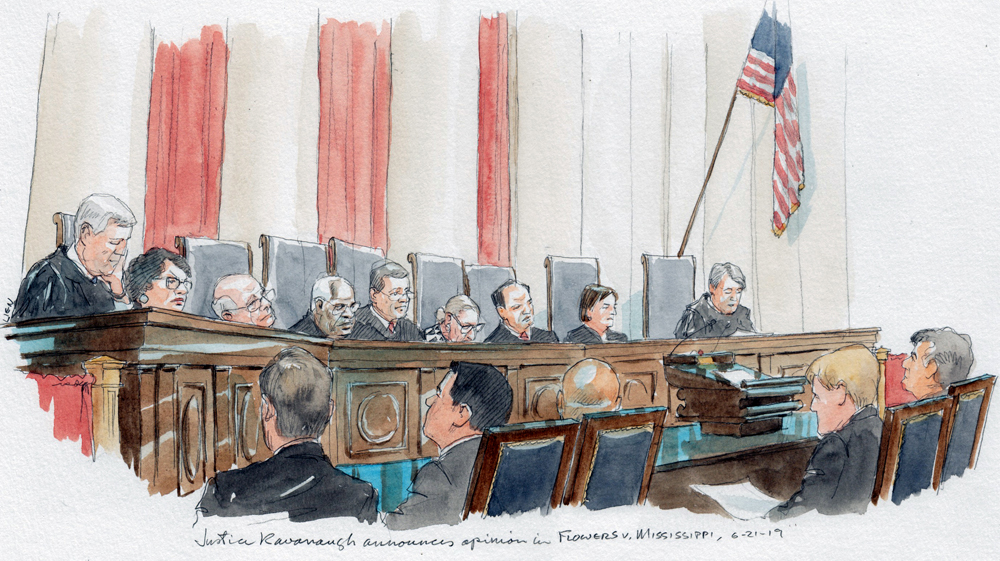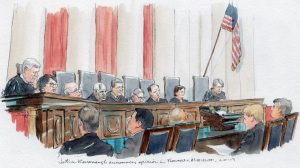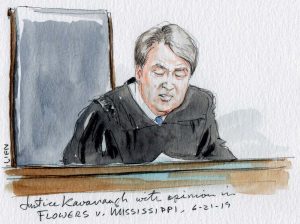A “view” from the courtroom: “We break no new legal ground”

on Jun 21, 2019 at 3:46 pm

It’s a blustery day in Washington as the court prepares for opinions. I’m tempted to call it a “rare” Friday session, but the justices issued opinions on this equivalent Friday last term, and they did the same in 2015 with the momentous same-sex marriage decision in Obergefell v. Hodges.
In the cafeteria this morning, Jimmy Hoover, the Supreme Court reporter for Law360, has spotted Justice Brett Kavanaugh’s father, Edward Kavanaugh, who will join Kavanaugh’s mother, Martha (the original Judge Kavanaugh in the family) in the VIP section of the courtroom. Perhaps we have an opinion coming from the first-year justice.
A couple of blocks away, Gabe Roth of Fix the Court, an organization that has been hammering for more Supreme Court transparency, and other witnesses are testifying at a House Judiciary Committee subcommittee hearing on promoting ethics, accountability and transparency in the federal judiciary. Roth sees something suspect about the court’s decision to issue opinions today.
“I’m testifying before Congress tmrw. so of course there will be opinion announcements,” is the caption on his Thursday night email to Supreme Court reporters. He suggests that the reporters could cover both the hearing and today’s opinions by pointing out that it is just a nine-minute walk from the Rayburn House Office Building, where the hearing will be, to the Supreme Court building. Roth has perhaps underestimated how much Supreme Court reporters are creatures of habit who prefer to get settled at the court well before the opinions come down.
At 9:45 a.m., in the Supreme Court chamber, the public gallery is barely half full, while the bar section is wide open, with just two seats filled. But the public section will nearly fill up with some further arrivals, and the bar section will rise to six members, equaling the number of representatives from the solicitor general’s office.
Taking a seat in the front row of the bar is Jeffrey Green of Sidley Austin, a criminal-defense specialist who participated in at least one case pending decision.
The court takes the bench and Chief Justice John Roberts pauses to let everyone settle in their seats before announcing that the opinion in Flowers v. Mississippi “is delivered by Justice Kavanaugh.” It’s a slightly odd present-tense construction, but, hey, he has to do this about 70 times per term.
This capital case from Mississippi was the subject of an intense oral argument in March. Curtis Flowers, the petitioner, is accused of murdering four people at the Tardy Furniture store in small-town Winona, Miss. Flowers has been tried six times, each by the same lead prosecutor.
Flowers is black, and questions of whether black potential jurors were improperly struck by the prosecution with its peremptory challenges surround several of the trials, including the sixth one, which is the one specifically before the justices. In that trial, Flowers was convicted, and the Mississippi Supreme Court upheld his conviction, turning away his claim under Batson v. Kentucky that the state’s exercise of peremptory challenges to exclude five out of six black prospective jurors was discriminatory.
At the oral argument, Kavanaugh observed that “we can’t take the history out of the case.”
The argument also offered a rare set of questions from Justice Clarence Thomas, who elicited from the lawyer for Flowers that the defendant’s trial counsel had exercised peremptory challenges against white prospective jurors.
Today, Kavanaugh explains the procedural history, describes small town Winona, and reminds everyone about an 1880 decision, Strauder v. West Virginia, which struck down that state’s statute excluding blacks from jury service.
“The court explained that the 14th Amendment required ‘that the law in the states shall be the same as for the black as for the white.’”
But Strauder did not solve the problem of racial exclusion from jury service, Kavanaugh adds, leading to the 1986 decision in Batson.
He announces that the state did violate Batson.
“The numbers speak loudly,” he says, with the state using peremptory challenges to strike 41 of 42 black prospective jurors in the six trials combined.
“We cannot ignore that history. We cannot take that history out of the case,” he says, echoing his observation from oral argument.
Kavanaugh goes into some factors of the sixth trial in greater detail, including that the state’s peremptory challenge of one black prospective juror in particular “was motivated in substantial part by discriminatory intent.”
“In reaching that conclusion, we break no new legal ground,” he says. “We simply enforce and reinforce our decision in Batson by applying it to the extraordinary facts of this case.”
The justices had struggled a bit at oral argument to find a broader principle in the case, but this seems to be an instance in which the court has settled for error correction.
Justice Samuel Alito has a concurring opinion, and Thomas has a dissent, joined in part by Justice Neil Gorsuch. Thomas does not deliver any of his sharp dissent from the bench.
Justice Sonia Sotomayor is up next with the opinion in North Carolina Department of Revenue v. Kaestner 1992 Family Trust.
“This case is about the limits on a state’s power to tax a trust,” she says. The holding is that the presence of in-state beneficiaries alone does not empower a state to tax trust income that has not been distributed to the beneficiaries when they have no right to demand the income and are uncertain to receive it.
The opinion is unanimous, with Alito filing a concurring opinion joined by Roberts and Gorsuch.
Justice Stephen Breyer has the opinion in Rehaif v. United States, which holds that in a prosecution under a federal statute that prohibits certain categories of people from possessing firearms, the government must prove that the defendant knew he possessed a firearm and that he knew he belonged to the relevant category.
Breyer points out that “the distinction matters in this case,” because a trial court instructed a jury that it did not need to find that the defendant, Hamid Rehaif, knew he was an alien in this country unlawfully.
“We hold that the government must prove both knowledge of conduct and knowledge of status,” Breyer says. He cites Blackstone and the concept of proof of scienter.
“Take the example of an immigrant who was brought to this country as a small child,” Breyer says. “Would Congress have intended to send such a person to prison for possessing a firearm even though she did not know that she was here unlawfully? We presume that Congress does not intend to make criminals out of such persons, who lack knowledge of the facts that would make their conduct wrongful.”
Although the legal issues and posture are very different, Breyer’s choice of example brings to mind the long-pending cert petitions concerning the status of the Deferred Action for Childhood Arrivals program.
Breyer notes that Alito has filled a dissent joined by Thomas. Jeffrey Green was on the merits brief for Rehaif in this case, and he has a look of satisfaction at the outcome today.
The chief justice announces that he has the opinion in Knick v. Township of Scott. Pennsylvania. This is the case that was argued during the first week of the term, before Kavanaugh was confirmed. In November, it was restored to the calendar for reargument, which occurred in January.
The conventional wisdom was that the court was deadlocked and needed Kavanaugh’s vote to break the tie.
Roberts explains that the case involves petitioner Rose Mary Knick’s 90-acre property in Scott Township, which includes a grazing area for horses and other animals and a small graveyard where ancestors of Knick’s neighbors “are allegedly buried.”
The phrasing adds an air of mystery to the case, and the record reflects that Knick has disputed whether there is any burial ground on her property. (We long thought that Oct. 31, a day the court held arguments last fall, would have been the more appropriate time for the initial argument in the case.)
Knick challenged a county ordinance that requires all cemeteries to be kept open and accessible to the public during daylight hours as a taking that violated the Fifth Amendment’s takings clause.
The high court took up the case to reconsider its 1985 decision in Williamson County Regional Planning Commission v. Hamilton Bank of Johnson County. That case held that a property owner whose property has been taken by a local government has not suffered a Fifth Amendment violation — and cannot bring a federal takings claim in federal court — until a state court has denied his claim for just compensation under state law.
Roberts says Knick is caught in a Catch-22 between Williamson County and a later decision, 2005’s San Remo Hotel L.P. v. City and County of San Francisco, which held that a state court’s resolution of a claim for just compensation under state law will generally preclude any federal suit.
“That should tip us off that something is wrong,” Roberts says. “We decide today that the something that is wrong is Williamson County.”
He says the balance of considerations over stare decisis “tips in favor of overruling” the state-litigation requirement of Williamson County. He does not address the sharp words of the dissent about yet another precedent being overruled, but concludes by stating that “a federal court, no less than a state court, is competent” to hear Knick’s takings claim.
He announces that Justice Elena Kagan has the dissent, joined by Justices Ruth Bader Ginsburg, Breyer and Sotomayor. Kagan does not read from her dissent. And it is now clear that Kavanaugh indeed had the decisive vote in this case.
The justices rise to depart the bench, and there is not much suspense this time in Marshal Pamela Talkin’s announcement that the court will return on Monday, because Monday is a regularly scheduled day for opinions.
There are 12 opinions left, and to paraphrase Roth, “of course there will be opinion announcements” on one or more additional days. Most of those are expected to break some legal ground.




